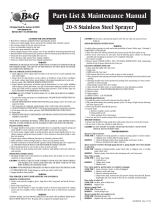STIHL SG 31 is a sprayer suitable for applying chemicals and other liquids to control pests and weeds in areas like fruit and vegetable growing, horticulture, plantations, grassland, and forestry. It features a pump for pressurizing the tank and a variety of nozzles for different spraying applications. The SG 31 is designed for easy handling, with adjustable straps for comfortable carrying and a range of accessories for specific tasks.
STIHL SG 31 is a sprayer suitable for applying chemicals and other liquids to control pests and weeds in areas like fruit and vegetable growing, horticulture, plantations, grassland, and forestry. It features a pump for pressurizing the tank and a variety of nozzles for different spraying applications. The SG 31 is designed for easy handling, with adjustable straps for comfortable carrying and a range of accessories for specific tasks.




















-
 1
1
-
 2
2
-
 3
3
-
 4
4
-
 5
5
-
 6
6
-
 7
7
-
 8
8
-
 9
9
-
 10
10
-
 11
11
-
 12
12
-
 13
13
-
 14
14
-
 15
15
-
 16
16
-
 17
17
-
 18
18
-
 19
19
-
 20
20
-
 21
21
-
 22
22
-
 23
23
-
 24
24
STIHL SG 31 is a sprayer suitable for applying chemicals and other liquids to control pests and weeds in areas like fruit and vegetable growing, horticulture, plantations, grassland, and forestry. It features a pump for pressurizing the tank and a variety of nozzles for different spraying applications. The SG 31 is designed for easy handling, with adjustable straps for comfortable carrying and a range of accessories for specific tasks.
Ask a question and I''ll find the answer in the document
Finding information in a document is now easier with AI
Related papers
Other documents
-
Total THSPP2021 Owner's manual
-
Ryobi OWS1870 Original Instructions Manual
-
HDX 1501HDXA User guide
-
Total THSPP4161 Owner's manual
-
 B&G 3-SPB Maintenance Manual
B&G 3-SPB Maintenance Manual
-
Sanela SLT 04 Mounting instructions
-
HDX 1502HDX Operating instructions
-
Kreator KRTGR6805 Owner's manual
-
Kreator KRTGR6805 Owner's manual
-
Craftsman 78615160 Owner's manual
























